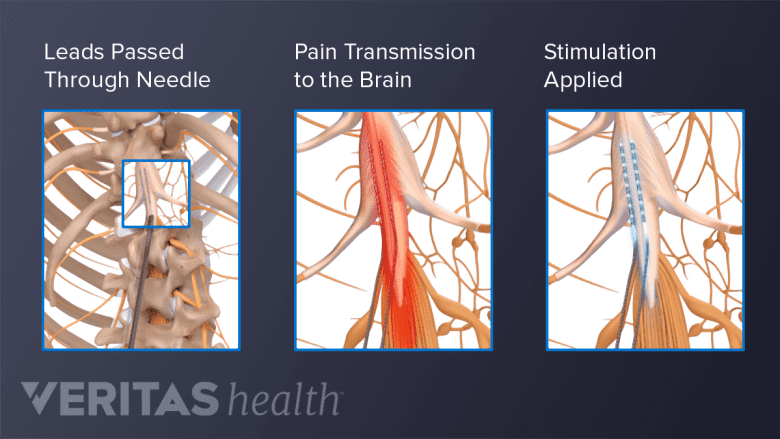A successful trial is an essential precursor for the permanent implantation of a spinal cord stimulator. The trial phase of spinal cord stimulation (SCS) treatment involves a relatively simple injection procedure.1Dydyk AM, Tadi P. Spinal Cord Stimulator Implant. [Updated 2022 Jul 4]. In: StatPearls [Internet]. Treasure Island (FL): StatPearls Publishing; 2022 Jan-. Available from: https://www.ncbi.nlm.nih.gov/books/NBK555994/ While patients can return home soon after the procedure, getting used to the new device may cause some level of discomfort and uneasiness.
In This Article:
- Recovery After Spinal Cord Stimulator Implant Surgery
- Recovery After Spinal Cord Stimulation Trial
- Recovery After a Permanent Implant for SCS Treatment
How Long an SCS Trial Lasts
The SCS trial phase lasts for 3 to 7 days, on average.1Dydyk AM, Tadi P. Spinal Cord Stimulator Implant. [Updated 2022 Jul 4]. In: StatPearls [Internet]. Treasure Island (FL): StatPearls Publishing; 2022 Jan-. Available from: https://www.ncbi.nlm.nih.gov/books/NBK555994/ The trial is designed to determine the treatment's efficacy and the patient's device tolerance before a permanent implant is done.2Garcia K, Wray JK, Kumar S. Spinal Cord Stimulation. [Updated 2022 Jul 10]. In: StatPearls [Internet]. Treasure Island (FL): StatPearls Publishing; 2022 Jan-. Available from: https://www.ncbi.nlm.nih.gov/books/NBK553154/ The goal is to evaluate if the patient experiences at least a 50% reduction in pain and/or 50% improvement in functionality–which is considered a successful trial. In such cases, patients may continue with a permanent implant, if the surgeon approves.2Garcia K, Wray JK, Kumar S. Spinal Cord Stimulation. [Updated 2022 Jul 10]. In: StatPearls [Internet]. Treasure Island (FL): StatPearls Publishing; 2022 Jan-. Available from: https://www.ncbi.nlm.nih.gov/books/NBK553154/
Activity restrictions apply to both the trial phase and the permanent implant.
What Happens in a Spinal Cord Stimulation Trial
Lead wires are inserted into the epidural space via a needle to target and address spinal pain.
The trial is performed as an outpatient procedure in an operating room. The entire procedure may take an hour to 90 minutes.
The procedure involves administering sedation medication to the patient and threading the leads into the spinal epidural space (the area surrounding the spinal cord) through a hollow needle. The entire procedure is performed under x-ray guidance (fluoroscopy).2Garcia K, Wray JK, Kumar S. Spinal Cord Stimulation. [Updated 2022 Jul 10]. In: StatPearls [Internet]. Treasure Island (FL): StatPearls Publishing; 2022 Jan-. Available from: https://www.ncbi.nlm.nih.gov/books/NBK553154/
The outer ends of the leads are connected to a stimulator or pulse generator, which is worn outside the patient’s body.
The stimulator is about the size of a wallet.
Post-Surgical Monitoring at the Hospital
The patient's vital signs are monitored until the effect of the sedation wears off (about 30 minutes to an hour). The pulse generator device is programmed, and the patient is discharged. A manual, handheld device helps program the pulse generator. The patient is instructed on how to use this device at home for SCS treatment.
It is not advisable for patients to drive home after the procedure. Arranging for a friend or family member to drive is recommended.
Recovering at Home After a Spinal Cord Stimulation Trial

The leads placed at specific points in the spine help control pain by inhibiting the pain signals.
The trial phase of SCS does not include the surgical implantation of the pulse generator. Only the leads are inserted into the epidural space. This setup is temporary, and patients may feel slight discomfort or soreness at the site(s) where the needle was inserted into the skin.
Soreness may be treated with ice packs or topical pain medication if approved by the doctor. It is advisable to rest for 1-2 days after the insertion of the leads while the body adjusts to the new treatment.
Activity Restrictions During the SCS Trial Period
Activity restrictions help provide better treatment outcomes and protect the device.
- No full baths or showers. Since the pulse generator device is secured outside the body, care must be taken to not get the device in contact with water. Patients are instructed to take a sponge bath and avoid showers, full baths, or water activities.
- No strenuous physical activities. Engaging in heavy or strenuous physical activities is discouraged due to the risk of migration or breakage of the leads.
- Move with caution. Bending, twisting, stretching, and raising the arms above the shoulder level can cause the leads to migrate, so these movements must be restricted as much as possible.
- Driving restrictions. When the stimulator is turned on, driving and other activities requiring focus, such as operating machinery should not be performed.
Medications must be taken in a timely manner during the recovery period. A combination of pain-relieving medication and antibiotics is usually prescribed. All medications must be taken as directed. If the medication does not help with pain reduction or if any concerning symptoms occur, the physician should be consulted as soon as possible.
Maintaining a Pain Journal
Doctors advise patients to maintain a daily pain journal during the trial phase (and sometimes even after the permanent implant) that records any changes in symptoms during the treatment. Patients typically record answers to questions such as the following:
- Was there an improvement in pain? How would you grade the improvement on a scale of 0-10?
- Was there an improvement in function? How would you grade the improvement on a scale of 0-10?
- Was a specific setting more useful today?
- Was a specific setting more useful during a specific time of the day?
- Did a specific setting cause the symptoms to worsen?
Additionally, patients can write about their own experiences during the treatment, such as mood changes and feelings, which allows the healthcare team to adequately address any other concerns that may be observed during treatment.
- 1 Dydyk AM, Tadi P. Spinal Cord Stimulator Implant. [Updated 2022 Jul 4]. In: StatPearls [Internet]. Treasure Island (FL): StatPearls Publishing; 2022 Jan-. Available from: https://www.ncbi.nlm.nih.gov/books/NBK555994/
- 2 Garcia K, Wray JK, Kumar S. Spinal Cord Stimulation. [Updated 2022 Jul 10]. In: StatPearls [Internet]. Treasure Island (FL): StatPearls Publishing; 2022 Jan-. Available from: https://www.ncbi.nlm.nih.gov/books/NBK553154/
Editor’s Top Picks
- Spinal Cord Stimulation: The Trial Period
- Spinal Cord Stimulation for Chronic Back and Neck Pain
- Spinal Cord Stimulator Implantation Surgery: Step by Step
- Spinal Cord Stimulation for Chronic Neck Pain Video
- Spinal Cord Stimulation for Chronic Back Pain Video
- Who May Benefit from Spinal Cord Stimulation

